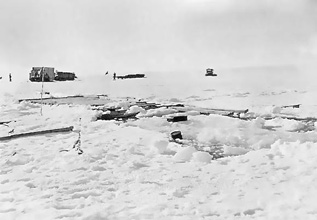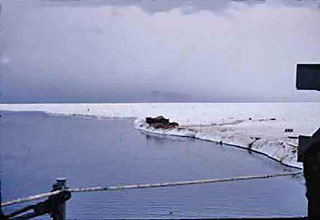The death of Richard T. Williams | |
|
Seabee Construction Driver third class Richard T. Williams, USN, died on 6 January 1956 when the D-8 bulldozer he was driving broke through the ice and sank. Above...two photos of the site of his demise. The original Deep Freeze runway site had been on shelf ice near Hut Point...so what was going on? At this hectic time, the Navy was still seeking out where to build a land airfield that could support flights from New Zealand as well as flights to inland destinations. Navy Captain Gerald Ketchum, in charge of operations at McMurdo, recommended a site on Ross Island between Cape Royds and Cape Evans after briefly visiting the area by helicopter. Accordingly, a cargo route was sought between the open channel and Cape Evans. On 5 January, the icebreaker Glacier arrived and unloaded a bridge which was set up to span a crack off of Cape Royds. The next day, the cargo vessel Wyandot began offloading cargo for the runway construction, and the first traverse to the site commenced. Williams was driving an LGP (I think) D-8, hauling the first construction materials for the Cape Evans runway site and camp, to begin leveling the camp site. A D-2 tractor was first driven successfully over the bridge with no signs of weakening, so Williams proceeded across. This was about two miles west of Cape Royds. When he was about halfway across the bridge, observers noted that the ice was beginning to sag. They shouted and waved for him to turn back, but he did not see or hear them, and continued forward, bouncing off of the 10-inch drop at the far end of the bridge. Twenty feet after crossing the bridge, a section of ice broke away, and the tractor disappeared immediately in the 600-foot-deep water. Although the escape hatch and side doors of the D-8 were locked open (and he was seen partway out of the tractor), Williams failed to escape, and his body was never recovered. After the incident, the offloaded cargo from Wyandot was reloaded, and plans were made to reach the safer ice near Hut Point, which had been the original unloading site, which was named the Williams Air Operating Facility. And on 6 January 1957, the "Our Lady of the Snows" shrine was erected on Hut Point in his memory. The photo credits...the left photo above is from Patrick "Rediron" McCormick, one of the folks who would later work on building the Pole station in 1956-57. His shared photo has a caption which I've edited out in the above version. The right photo is by Phil Richardson, from his website. He was a crew member on the tanker Nespelen and took the photo from that ship later in the season as it passed through the cleared channel. His photo depicts the remnants of the bridge. Other credits...the Task Force 43 Deep Freeze I cruisebook, the US Navy Deep Freeze I Summary of Operations (originally online from the US Naval Historical Center), and Dian Belanger's excellent book Deep Freeze (Amazon.com link). | |

